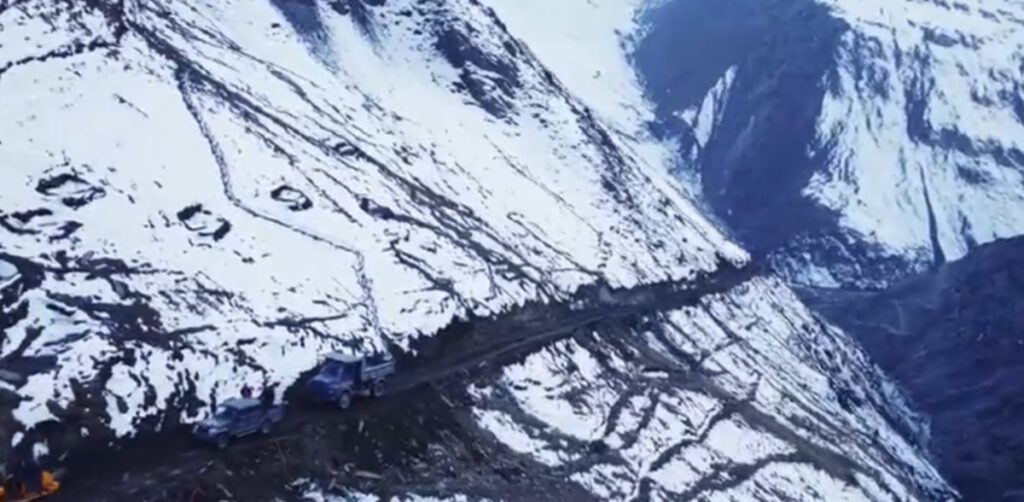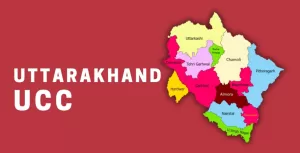The construction of a road to the Amarnath cave shrine in the Himalayas has triggered a political storm in Jammu and Kashmir with the opposition parties and some Kashmiri Pandits terming the move as a “catastrophe in the making”.
In a video titled ‘Our Men Our Mission – We will either find a way or make one’, the Border Road Organisation said on X (formerly Twitter) that it has “created history” after a set of vehicles arrived at the holy shrine “for first time” earlier this month.
Drone footage released by the BRO shows a mini-truck tailed by a dumper trundling along the road that has been built on the slopes of the eco-fragile Himalayan mountains from Chandanwari side in Lidder Valley, one of the two gateways to the cave shrine.
The 2-minute and 27-second video, which has been dedicated to the “Karamyogis of BRO”, also shows a group of BRO engineers and workers posing for a photo in front of a heavy earth mower and a mechanical dumper set against the backdrop of the shrine’s entrance.
According to officials, the road widening has been carried out by the BRO from Sangam base ahead of Chandanwari in Pahalgam and a “new cut alignment” has been adopted till Sangam Top. The widening project has also been taken up from the lower cave area to the shrine which is visited by hundreds of thousands of Hindu pilgrims every year.
The development has riled the opposition in Jammu and Kashmir with the Peoples Democratic Party led by former J&K chief minister Mehbooba Mufti terming it as the “biggest crime” for Hinduism while CPI(M) accused the government of “overlooking the safety of pilgrims for political benefits”.
“Rather than making it a political issue or a question of prestige, the government should be more concerned about the safe passage of pilgrims to the shrine not only in terms of militancy but also environment,” said CPI (M) leader M.Y. Tarigami, adding that the road will make the region “more vulnerable to climate disasters”.
‘Vandalisation’
Pointing to the recent flooding in Himachal Pradesh, Tarigami claimed that the encroachment of the Himalayan ecosystem by road expansion and other construction activities will not bring any relief for the pilgrims “but only imperil their safety and security”.
“Kashmiri Muslims have always stood for the safety and welfare of the Hindu pilgrims who visit the shrine but such moves will have a devastating impact on our fragile environment,” Tarigami told The Wire.
Imran Dar, a spokesperson of the National Conference, said that the government should stop the “vandalisation” of Kashmir’s environment.
“We have seen how dangerous it can be when humans try to play with nature. The recent nature’s fury in Uttarakhand is a case in point. I hope the powers that be realise how sensitive these places are and stop such vandalisation of our mountains,” Dar told The Wire.
Mohit Bhan, a Kashmiri Pandit and PDP spokesperson said on X: “This is not history, it’s the biggest crime one can commit to Hinduism and its faith in nature. Hinduism is all about immersing in spiritual mother nature, that’s why our pilgrimages are in the lap of the Himalayas.”
Some prominent Kashmiri Pandits also criticised the road construction in the Himalayan region, arguing that the conversion of spiritual places into “concrete jungles” will have “disastrous” consequences for the Himalayan region where the vulnerabilities of climate change are already being felt by locals.
Questioning the motives behind the road construction, Kashmiri Pandit activist Satish Mahaldar said that the government is “refusing to learn the lessons” from the recent climate-induced disasters in India.
“Kedarnath was a real example where encroachment of natural ecosystems triggered nature’s fury and a humanitarian disaster. We saw how villages after villages sunk. Sadly, the government seems intent on bringing these disasters to Kashmir,” he said.
The BRO has completed the road at a time when the Union government has already approved a Rs 5300 crore project for 110-km four-lane highway to the holy cave shrine that also includes a major tunnel which will bore through the heart of the Himalayan region.
‘Religious significance’
The proposal for a Detailed Project Report for Amarnath highway has been floated by the Union Ministry of Road, Transport and Highways but its Environmental Assessment Report has not been made public by the ministry yet which has said that it will cut down the pilgrimage time from two to three days to few hours.
Urging the Union government to “respect the sanctity” of the Amarnath pilgrimage, Mahaldar said that the government’s decision to shorten the time for performing the pilgrimage by road construction will “ruin its religious significance.”
“Pilgrims are supposed to halt at certain places on the yatra route and undertake some rituals which can’t be done in a day, but it seems the government wants to turn this sacred pilgrimage into an adventure activity,” he said.
According to officials, the project comprises a 73-km stretch from Khanabal to Chandanwari in Anantnag district of south Kashmir worth Rs 1800 crore which is expected to be completed by 2023.
A 10-km long tunnel, which will connect Pahalgam and Sonamarg, the second and the shorter among the two routes to the cave shrine, will be part of the 37 km, Rs 3500 crore Chandanwari-Panjtarni-Baltal stretch of the highway.
When Jammu and Kashmir was a state, the two routes were maintained by local governments which were often under pressure from civil society activists and environmental groups to prevent a climate catastrophe at the cave shrine by limiting the footfall of pilgrims.
In 2022, more than dozen pilgrims were killed while several other pilgrims were injured when flash-floods hit a base camp near the cave shrine, prompting the authorities to suspend the pilgrimage indefinitely.
However, after the reading down of Article 370 in 2019, the routes were handed over to the BRO for maintenance which has been taking up expansion and repair activities before the start and after the culmination of the annual pilgrimage.
The shrine, which sits at an altitude of over 13000 feet, houses an ice stalagmite that is believed to be an incarnation of Lord Shiva. The shrine was discovered by Bota Malik, a Muslim shepherd from Anantnag district, in 1850.
The shrine, which finds mention in modern and medieval records dating back centuries, was managed by Malik’s family till 2005 when the shrine management board took control of the pilgrimage, pulling curtains on a decades-old practice that symbolised the essence of Kashmir’s syncretic culture.
(Courtesy: The Wire.)




